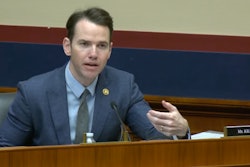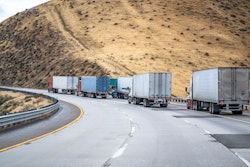
Welcome to California: home of beaches, mountains, deserts, and of course Regulations, Reporting, and Requirements. Oh my!
As folks were ringing in the New Year, many California fleets were also wringing their hands as they juggled multiple reporting requirements for several new fleet rules in the state. And these regulations are not only for those vehicles domiciled in California. Regulations have expanded to encompass vehicles that may occasionally roll through the state, with requirements for owners, operators, brokers and hiring entities.
Fleet operators may also need to enter the same vehicle into multiple reporting systems if the vehicle is diesel, natural gas, and/or equipped with a reefer.
The responsibilities for fleet management, even for fleets without California sites, are growing rapidly with the introduction of multiple new regulations created by the California Air Resources Board (CARB). Fleets of all sizes likely feel overwhelmed by how these cascading requirements impact their operations.
Here is a rundown of how these regulations can impact vehicle replacements and purchases, vehicle maintenance, reporting, and opportunities for funding.
Replacing your vehicles
CARB’s landmark Advanced Clean Fleets (ACF) Regulation became law in October 2023 and sets requirements to transition to zero emission vehicles (ZEVs) over the next two decades for drayage vehicles, State and Local Government Agency (SLGA) fleets, and High Priority and Federal (HPF) fleets. This historic new regulation’s impact started with reporting and procurement requirements for some fleets on Dec. 31, 2023.
Under ACF, all existing “legacy” diesel and natural gas drayage vehicles had to be registered in CARB’s reporting system before the end of 2023 to continue operation in California ports and intermodal railyards. As of Jan. 1, 2024, zero-emission vehicles (ZEVs) are the only vehicles allowed to be added into California drayage operations. HPF fleets can either phase-in ZEVs following CARB’s percentage-of-fleet targets, or commit to 100% ZEV additions into California as of Jan. 1, 2024 as they phase out existing assets. HPF includes most of the truckload (TL), less than TL (LTL), last-mile delivery (LMD), general logistics companies, and federal fleets operating in California. SLGA fleets must ensure that at least 50% of their vehicle purchase orders are ZEVs for calendar years 2024-2026, then exclusively ZEVs starting in 2027, or, alternatively, opt into the HPF phase-in percentage schedule.
These requirements represent a dramatic shift in the way fleets plan, purchase and operate their vehicles. Some organizations may be subject to more than one set of compliance pathways if, for instance, they operate both drayage and truckload divisions. This can present unique challenges and require additional considerations in procurement planning, compliance strategies and record-keeping for the fleet.
If you heard about CARB’s “hold” on the ACF regulation, it is important to know what this does and doesn't mean. CARB announced a voluntary delay on ACF enforcement for HPF and drayage fleets (not for SLGA) while awaiting EPA clarification on CARB’s authority to proceed. Although this may sound like a free pass, CARB has indicated they could retroactively enforce back to the start dates. Fleets mitigating risks will want to keep their plans moving ahead as if there is no enforcement delay.
Buying new vehicles
As advisors to fleets, one of the top questions we often hear is “How are these regulations going to impact costs and availability of vehicles?”While our magic-8-ball does not have that answer, we can tell you that California and more than 10 additional states have already adopted the sister regulation to the ACF Rule – the Advanced Clean Trucks (ACT) Regulation – which requires manufacturers to sell an increasing percentage of ZEVs. This is a signal that states are committed to ZEV policy pathways for manufacturers and, likely, fleets.
In addition to requiring ZEVs, California is also tightening emission standards on any allowable ICE vehicles as of January 2024. As a result, it is already tougher to find new ICE vehicles that meet California's Low-NOx standards, plus some vendors are pushing ZEV sales to meet their own sales mandates.
Reefers
Truck reefers have additional requirements for the temperature control system engines to meet emission standards or start transitioning to ZE. There are also limitations on which refrigerants are allowed.Vehicle maintenance
Starting this year, owners and operators must abide by a more robust smoke test program for non-gasoline heavy-duty vehicles (such as diesel and natural gas tractors), due to the new CARB Clean Truck Check (CTC) program. Older vehicles must conduct smoke testing twice per year and newer vehicles will submit on-board diagnostic (OBD) reports twice per year through 2026, and quarterly in 2027. These tests require certified technicians and CARB certified testing methods.Reporting
CARB adds new reporting requirements with each wave of regulation and has given the DMV the authority to withhold renewals for non-compliant vehicles. Vehicles and equipment may need to be reported in multiple systems for CTC-VIS for CTC Program, Truck Regulation Upload, Compliance and Reporting System (TRUCRS) for ACF, and ARB Equipment Registration (ARBER) system for truck and trailer reefers. Currently, only the CTC has reporting fees ($30 per vehicle).Hiring/brokering
Outsourcing fleet operations does not remove your requirements. CARB’s many rules require hiring entities and brokers to verify compliance of carriers before hiring or tendering loads.Funding
Fleets on top of their game juggling all the regulations may be able to seek funding through the vehicle and infrastructure programs available at the state, local and utility-level. Depending on your fleet type and size, these funding opportunities can substantially reduce the cost of ZEVs, equipment, charging infrastructure, and even some ongoing costs.Next steps
If planning for the ACF Rule has not been on your radar yet, it’s time to understand how this rule impacts your fleet. In our daily conversations with fleets, most are unaware, unprepared and simply running out of time, especially given the lengthy process to install zero-emission infrastructure and gather the necessary documentation needed to apply for ACF exemptions. For those with interstate operations, this can instigate significant discussions on deciding which vehicles are allowed to enter California.And if you pause while ACF enforcement is temporarily on hold, remember that CARB can retroactively reinstate all deadlines and requirements. You do not want to be caught behind schedule and watch your competitors carry-on, seemingly unscathed. That’s a lot to think about, especially for fleets without staff dedicated to managing such requirements.













